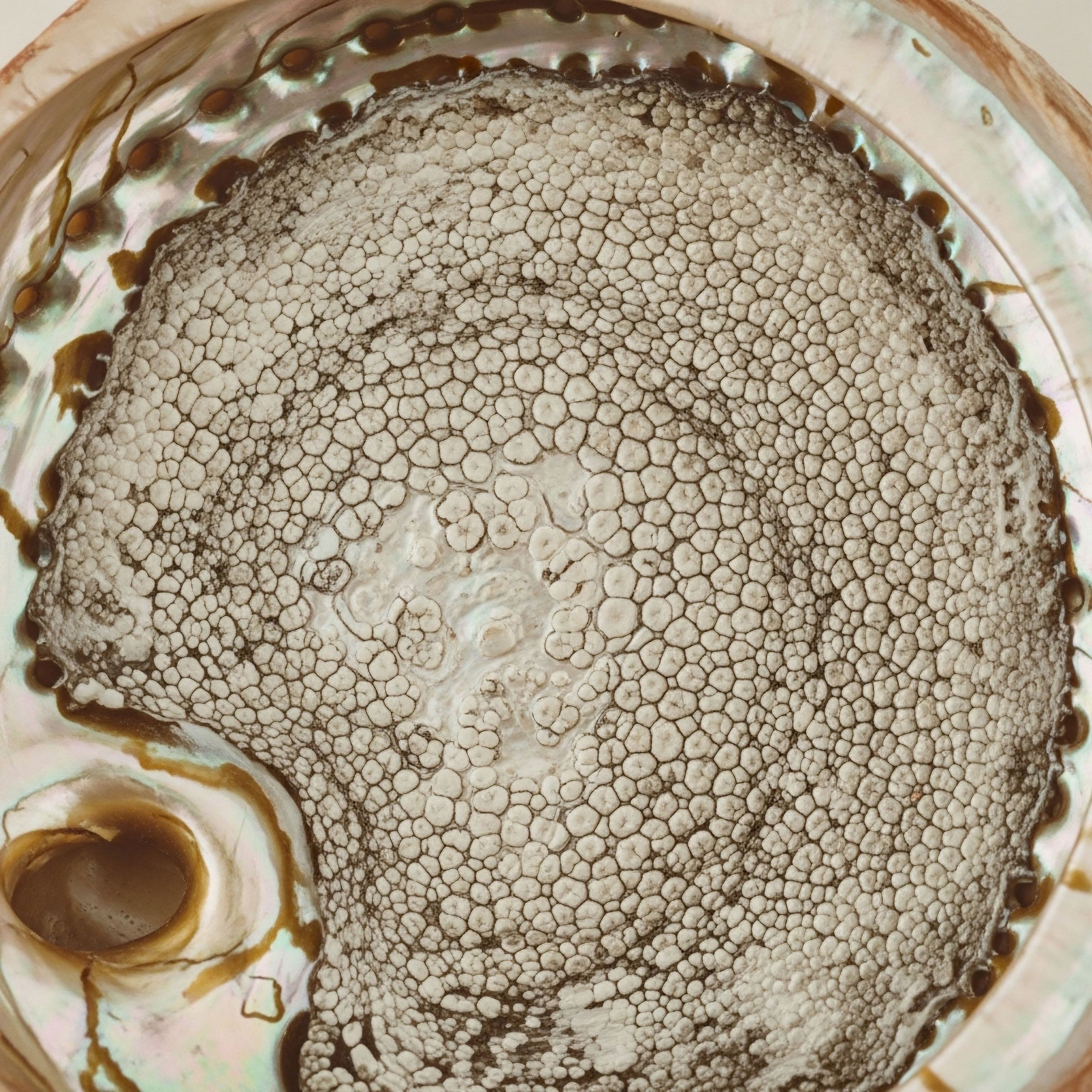

Fundamentals
The persistent fatigue that settles deep within your bones, the mental fog that obscures clarity, and the restless nights spent staring at the ceiling are not merely inconveniences; they are profound signals from your body. These experiences speak to a system out of balance, often whispering about the intricate dance of your hormones and their profound impact on every aspect of your well-being.
Sleep, far from being a passive state, represents a critical period of repair, restoration, and recalibration for your entire biological architecture. When this nightly reset is compromised, the repercussions ripple through your metabolic function, cognitive acuity, and emotional resilience. Understanding the biological underpinnings of these symptoms is the first step toward reclaiming your vitality and function without compromise.
The endocrine system, a complex network of glands and hormones, orchestrates countless bodily processes, including the sleep-wake cycle. Hormones serve as the body’s internal messaging service, carrying instructions to cells and tissues throughout your system. When these messages are disrupted, whether by age, stress, or environmental factors, the consequences can manifest as the very symptoms that diminish your quality of life. Addressing these concerns requires a precise, evidence-based approach that acknowledges the interconnectedness of your internal systems.

The Growth Hormone Axis and Sleep Quality
One significant player in this complex hormonal symphony is growth hormone (GH). Secreted by the pituitary gland, GH plays a vital role in tissue repair, cellular regeneration, and metabolic regulation. Its release follows a pulsatile pattern, with the largest bursts occurring during the deepest stages of sleep, specifically slow-wave sleep (SWS).
This nocturnal surge of GH is essential for muscle repair, fat metabolism, and maintaining healthy bone density. A disruption in sleep architecture, particularly a reduction in SWS, can directly impair GH secretion, creating a feedback loop that further compromises both sleep quality and overall physiological function.
Growth hormone secretagogues (GHS) represent a class of compounds designed to stimulate the body’s natural production and release of growth hormone. These agents do not introduce exogenous GH directly but rather encourage the pituitary gland to produce more of its own.
This approach aims to restore a more youthful and robust GH pulsatility, which can, in turn, support improved sleep architecture. The clinical consideration here is not simply about boosting GH levels, but about optimizing the body’s innate capacity for repair and regeneration, thereby addressing the root causes of sleep disturbances linked to hormonal decline.

How Hormonal Balance Influences Sleep Architecture
The relationship between hormonal balance and sleep architecture extends beyond growth hormone. Other endocrine signals, such as cortisol, melatonin, and sex hormones like testosterone and progesterone, also exert considerable influence. Cortisol, the primary stress hormone, naturally peaks in the morning and declines throughout the day, reaching its lowest point at night to facilitate sleep.
Chronic stress or dysregulation of the hypothalamic-pituitary-adrenal (HPA) axis can lead to elevated nighttime cortisol, making sleep initiation and maintenance challenging. Melatonin, produced by the pineal gland, signals darkness to the body, promoting drowsiness and regulating circadian rhythms.
Sex hormones also play a significant role. For women, fluctuations in estrogen and progesterone during the menstrual cycle, perimenopause, and post-menopause can severely disrupt sleep. Progesterone, in particular, has calming, anxiolytic properties that support sleep. For men, declining testosterone levels can contribute to sleep fragmentation and reduced SWS.
Addressing these broader hormonal imbalances alongside targeted GHS therapy can create a more comprehensive strategy for sleep optimization, recognizing that no single hormone operates in isolation. The body’s systems are interconnected, and a holistic approach often yields the most meaningful and lasting improvements.
Sleep disruption often signals deeper hormonal imbalances, with growth hormone playing a central role in nocturnal repair and regeneration.


Intermediate
When considering growth hormone secretagogues (GHS) for sleep optimization, understanding the specific agents and their mechanisms becomes paramount. These compounds operate by stimulating the body’s own growth hormone release, offering a more physiological approach compared to direct growth hormone administration. The objective extends beyond simply increasing GH levels; it involves restoring the natural pulsatile release that is critical for its biological effects, particularly those related to sleep architecture and recovery.

Growth Hormone Secretagogue Protocols
Several key peptides are utilized in growth hormone peptide therapy, each with distinct properties and applications. Their selection and dosing are tailored to individual needs, considering factors such as age, existing hormonal status, and specific sleep challenges. The administration route is typically subcutaneous injection, often performed nightly to align with the body’s natural GH release patterns during sleep.

Commonly Utilized Peptides and Their Actions
- Sermorelin ∞ This peptide is a growth hormone-releasing hormone (GHRH) analog. It acts on the pituitary gland to stimulate the natural production and release of growth hormone. Sermorelin’s action is considered gentle and physiological, as it relies on the pituitary’s own capacity to produce GH, thereby minimizing the risk of overstimulation. Its primary benefit for sleep optimization stems from its ability to enhance the natural nocturnal surge of GH, which can lead to improved slow-wave sleep.
- Ipamorelin / CJC-1295 ∞ This combination often represents a more potent GHS strategy. Ipamorelin is a selective growth hormone secretagogue that mimics ghrelin, stimulating GH release without significantly affecting other pituitary hormones like cortisol or prolactin. CJC-1295 is a GHRH analog with a longer half-life, providing a sustained release of GHRH. When combined, they offer a synergistic effect, leading to a more robust and prolonged GH pulsatility. This enhanced GH release can significantly improve sleep quality, particularly the restorative deep sleep phases.
- Tesamorelin ∞ While primarily known for its role in reducing visceral fat in HIV-associated lipodystrophy, Tesamorelin is also a GHRH analog. Its impact on sleep is indirect, primarily through its metabolic effects and overall improvement in body composition, which can contribute to better sleep quality.
- Hexarelin ∞ This is another ghrelin mimetic, similar to Ipamorelin, but generally considered more potent. It stimulates GH release through multiple pathways. Due to its higher potency, its use requires careful consideration and monitoring, particularly regarding potential effects on other hormones.
- MK-677 ∞ This is an orally active, non-peptide growth hormone secretagogue. It acts as a ghrelin receptor agonist, stimulating GH release and increasing IGF-1 levels. Its oral bioavailability makes it a convenient option for some individuals. Like other GHS, its ability to enhance GH pulsatility can support improved sleep architecture and overall recovery.

Clinical Monitoring and Individualized Adjustments
The implementation of GHS for sleep optimization necessitates rigorous clinical monitoring. This includes baseline and periodic laboratory assessments to evaluate growth hormone levels, Insulin-like Growth Factor 1 (IGF-1), and other relevant hormonal markers. IGF-1 serves as a reliable indicator of overall GH activity in the body. Monitoring these levels helps ensure that the therapy is effective and that GH levels remain within a physiological range, avoiding potential adverse effects associated with excessive stimulation.
Individualized adjustments to dosing and peptide selection are a cornerstone of successful GHS therapy. A patient’s response to treatment can vary based on their unique physiology, age, and underlying health conditions. The “Clinical Translator” approach emphasizes a dynamic treatment plan, where protocols are refined based on objective lab data and subjective patient feedback regarding sleep quality, energy levels, and overall well-being. This iterative process ensures that the therapeutic intervention is precisely aligned with the individual’s biological needs.
Growth hormone secretagogues stimulate the body’s natural GH production, aiming to restore physiological pulsatility for enhanced sleep and recovery.
Consider the following table outlining common GHS peptides and their primary mechanisms ∞
| Peptide Name | Primary Mechanism of Action | Typical Administration |
|---|---|---|
| Sermorelin | GHRH analog, stimulates pituitary GH release | Subcutaneous injection, often nightly |
| Ipamorelin / CJC-1295 | Ipamorelin (ghrelin mimetic) + CJC-1295 (long-acting GHRH analog) | Subcutaneous injection, often nightly |
| Tesamorelin | GHRH analog, primarily metabolic effects | Subcutaneous injection |
| Hexarelin | Ghrelin mimetic, potent GH secretagogue | Subcutaneous injection |
| MK-677 | Oral ghrelin receptor agonist | Oral tablet, daily |


Academic
The profound connection between growth hormone dynamics and sleep architecture represents a complex interplay within the neuroendocrine system. A deeper exploration reveals that the pulsatile release of growth hormone, particularly during the initial hours of nocturnal sleep, is not merely coincidental but mechanistically linked to the restorative properties of slow-wave sleep (SWS).
This deep sleep phase is characterized by high-amplitude, low-frequency delta waves on an electroencephalogram (EEG) and is critical for synaptic plasticity, cellular repair, and metabolic regulation.

Neuroendocrine Regulation of Sleep and Growth Hormone
The primary driver of growth hormone secretion is Growth Hormone-Releasing Hormone (GHRH), synthesized in the arcuate nucleus of the hypothalamus. GHRH acts on somatotroph cells in the anterior pituitary, prompting GH release. Conversely, somatostatin, also produced in the hypothalamus, inhibits GH secretion. The balance between GHRH and somatostatin dictates the pulsatile nature of GH release.
During SWS, there is a marked decrease in somatostatin tone and an increase in GHRH activity, facilitating the robust nocturnal GH surge. This intricate feedback loop underscores the body’s inherent wisdom in synchronizing anabolic processes with periods of rest.
The ghrelin-GH secretagogue receptor (GHSR) system also plays a significant role. Ghrelin, a peptide primarily produced in the stomach, acts on GHSRs in the hypothalamus and pituitary to stimulate GH release. Synthetic GHS peptides, such as Ipamorelin and Hexarelin, mimic ghrelin’s action, providing a pharmacological means to enhance endogenous GH secretion.
These agents bypass the need for exogenous GH, working with the body’s natural regulatory mechanisms to promote a more physiological release pattern. The goal is to restore the amplitude and frequency of GH pulses, which are often diminished with age, thereby supporting the physiological processes that rely on optimal GH signaling, including sleep quality.

Interplay with Other Hormonal Axes and Neurotransmitters
The influence of GHS on sleep is not isolated to the GH axis. There is a broader systems-biology perspective to consider. The hypothalamic-pituitary-adrenal (HPA) axis, governing the stress response, and the hypothalamic-pituitary-gonadal (HPG) axis, regulating sex hormones, are deeply intertwined with sleep.
Chronic stress, leading to HPA axis dysregulation and elevated nighttime cortisol, can suppress GH release and disrupt SWS. Conversely, optimizing GH levels through GHS may indirectly modulate HPA axis activity, promoting a more balanced stress response.
Sex hormones also exert direct effects on sleep architecture. Progesterone, particularly its neurosteroid metabolite allopregnanolone, acts as a positive allosteric modulator of GABA-A receptors, promoting calming and sedative effects. This explains why progesterone supplementation, often part of female hormone optimization protocols, can significantly improve sleep quality.
Testosterone, in both men and women, contributes to overall vitality and can impact sleep quality, with low levels sometimes associated with sleep disturbances. The judicious use of GHS, alongside targeted hormone replacement therapies like Testosterone Cypionate or Progesterone, creates a synergistic approach to sleep optimization by addressing multiple hormonal contributors.
Furthermore, neurotransmitters like GABA (gamma-aminobutyric acid) and serotonin are critical for sleep regulation. GABA is the primary inhibitory neurotransmitter in the central nervous system, promoting relaxation and reducing neuronal excitability. Serotonin, a precursor to melatonin, also plays a role in mood and sleep-wake cycles. While GHS directly influence GH, their downstream effects on metabolic health and overall endocrine balance can indirectly support optimal neurotransmitter function, thereby contributing to improved sleep.
Optimizing growth hormone secretion through GHS can restore the body’s natural sleep architecture, particularly slow-wave sleep, by modulating neuroendocrine feedback loops.

Clinical Evidence and Considerations for GHS in Sleep Optimization
Clinical studies have explored the impact of GHS on sleep parameters. Research indicates that agents like Sermorelin and Ipamorelin can increase GH pulsatility and IGF-1 levels, which correlate with improvements in sleep quality and an increase in SWS duration. This is particularly relevant for aging individuals, where natural GH secretion declines, contributing to age-related sleep fragmentation. The therapeutic application of GHS aims to reverse some of these age-associated changes, promoting more restorative sleep.
A critical consideration involves the precise timing of GHS administration. Mimicking the body’s natural nocturnal GH surge often involves subcutaneous injections before bedtime. This timing maximizes the physiological impact on sleep-related GH release. Dosage titration is also essential, guided by both subjective patient reports of sleep improvement and objective laboratory markers such as IGF-1 levels. The goal is to achieve physiological optimization, not supraphysiological levels, to minimize potential side effects and maintain long-term safety.
What are the long-term metabolic implications of GHS therapy for sleep?
The table below provides a summary of the physiological effects of growth hormone and its secretagogues on sleep and related systems ∞
| Physiological Effect | Impact on Sleep | Relevance to GHS Therapy |
|---|---|---|
| Increased Slow-Wave Sleep (SWS) | Directly enhances restorative sleep phases | Primary target for GHS, improves sleep architecture |
| Enhanced Cellular Repair & Regeneration | Supports nocturnal recovery processes | Contributes to overall vitality and reduced fatigue |
| Improved Fat Metabolism | Can reduce sleep-disrupting metabolic imbalances | Indirectly supports better sleep through metabolic health |
| Modulation of HPA Axis | Can help normalize cortisol rhythms | Addresses stress-related sleep disturbances |
| Support for Neurotransmitter Balance | Indirectly promotes calming and sleep-inducing signals | Contributes to overall sleep quality |

References
- Boron, Walter F. and Edward L. Boulpaep. Medical Physiology. 3rd ed. Elsevier, 2017.
- Guyton, Arthur C. and John E. Hall. Textbook of Medical Physiology. 13th ed. Elsevier, 2016.
- Veldhuis, Johannes D. et al. “Growth Hormone Secretion in Humans ∞ Physiological and Clinical Aspects.” Journal of Clinical Endocrinology & Metabolism, vol. 91, no. 12, 2006, pp. 4735-4745.
- Copinschi, Georges. “Growth Hormone and Sleep.” Sleep Medicine Reviews, vol. 10, no. 1, 2006, pp. 1-10.
- Giustina, Andrea, et al. “Growth Hormone and Sleep ∞ A Reciprocal Relationship.” Endocrine Reviews, vol. 38, no. 3, 2017, pp. 297-323.
- Nieschlag, Eberhard, et al. Testosterone ∞ Action, Deficiency, Substitution. 5th ed. Cambridge University Press, 2012.
- Stachenfeld, Nina S. “Sex Hormone Effects on Sleep and Sleep Disorders.” Sleep Medicine Clinics, vol. 14, no. 2, 2019, pp. 195-207.
- Sassone-Corsi, Paolo, and Joseph S. Takahashi. “Circadian Rhythms and Metabolism ∞ From Molecules to Systems.” Cell, vol. 161, no. 1, 2015, pp. 146-162.

Reflection
The journey toward optimizing sleep and reclaiming your vitality is deeply personal, reflecting the unique symphony of your own biological systems. Understanding the intricate connections between growth hormone, other endocrine signals, and the quality of your sleep represents a powerful step. This knowledge is not merely academic; it is a lens through which you can begin to interpret the signals your body sends, moving beyond the frustration of symptoms to a place of informed action.
Your personal health journey begins with understanding your body’s unique biological signals and responding with informed, personalized strategies.
Consider this exploration of growth hormone secretagogues and sleep as an invitation to engage more deeply with your own physiology. The insights gained here serve as a foundation, prompting further inquiry into how personalized wellness protocols can recalibrate your system. Each individual’s endocrine landscape is distinct, requiring a tailored approach that respects these biological differences.
How can personalized hormonal assessments guide your sleep optimization strategy?
Reclaiming vibrant health involves a partnership between your lived experience and precise clinical understanding. The path to restorative sleep and sustained well-being is not a one-size-fits-all solution; it is a dynamic process of listening to your body, interpreting its needs, and applying evidence-based strategies to restore balance. This proactive engagement with your health empowers you to function at your fullest potential, experiencing the profound benefits of truly restorative sleep.



